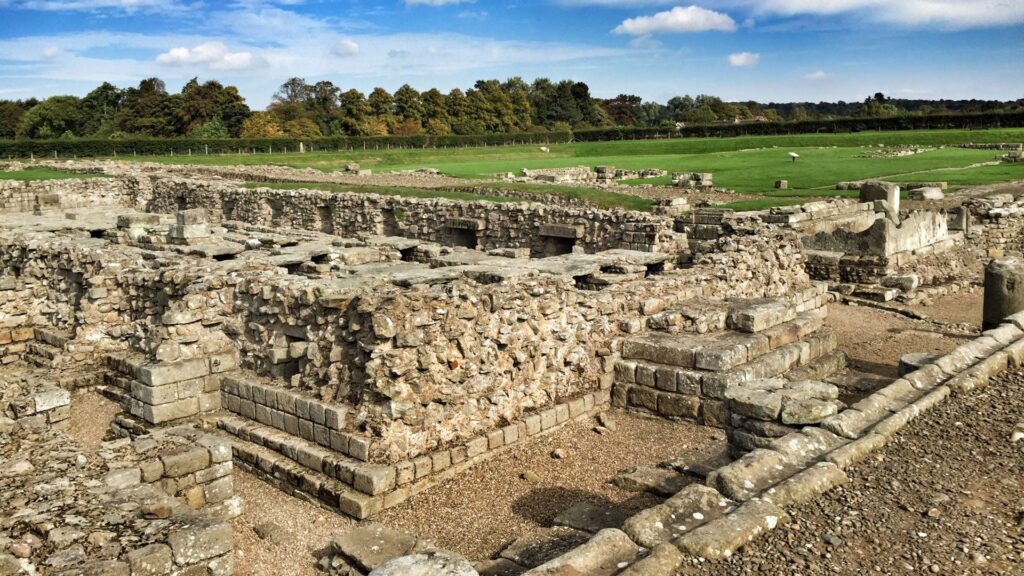Hadrian’s Wall: Roman Heritage in Northumberland
Hadrian’s Wall is a remarkable historical site that stretches across the north of England, offering a glimpse into the Roman Empire’s past. This ancient fortification, built under the orders of Emperor Hadrian, is a testament to Roman engineering and ambition. Nestled in the scenic landscapes of Northumberland, it provides a unique blend of history, culture, and natural beauty, making it a must-visit for history enthusiasts and nature lovers alike.
What to See
When visiting Hadrian’s Wall, there are several key sites that you shouldn’t miss. The wall itself, stretching 73 miles from Wallsend in the east to Bowness-on-Solway in the west, is dotted with fascinating ruins and forts. Housesteads Roman Fort is one of the best-preserved forts along the wall, offering stunning views of the surrounding countryside and a glimpse into Roman military life. The fort includes a visitor center with informative exhibits and artifacts.
Another highlight is Vindolanda, an active archaeological site where ongoing excavations continue to uncover Roman treasures. The Vindolanda Museum showcases a collection of artifacts, including the famous Vindolanda tablets, which are some of the oldest surviving handwritten documents in Britain.
For those interested in the natural beauty surrounding the wall, Sycamore Gap is a picturesque spot where a lone sycamore tree stands in a dramatic dip in the landscape. This location is not only a favorite among photographers but also a popular filming location, most notably featured in the movie “Robin Hood: Prince of Thieves.”
A Bit of History
Hadrian’s Wall was constructed starting in AD 122 during the rule of Emperor Hadrian. It was built to protect the Roman Empire from the tribes to the north and to assert Roman power in the region. The wall was originally about 15 feet high and 8 to 10 feet wide, with a series of forts, milecastles, and watchtowers along its length. It served as a military defense line and a customs post to control trade and migration.
Over the centuries, the wall fell into disrepair, with stones being repurposed for other buildings. However, its historical significance was recognized, and efforts to preserve and study the wall have been ongoing since the 19th century. Today, it is a UNESCO World Heritage Site, attracting visitors from around the world.
Interesting Facts and Tips for First-Time Visitors
- Hadrian’s Wall is the largest Roman archaeological feature in Britain and one of the most significant remnants of the Roman Empire.
- The wall was not just a defensive structure but also a symbol of Roman power and engineering prowess.
- The Hadrian’s Wall Path is a popular walking trail that follows the wall’s route, offering a unique way to explore the landscape and history. The trail is 84 miles long and can be walked in sections or in its entirety over several days.
- The wall inspired George R.R. Martin’s “The Wall” in his “A Song of Ice and Fire” series, which was adapted into the popular TV show “Game of Thrones.”
- For those visiting for the first time, it’s advisable to wear comfortable walking shoes and bring weather-appropriate clothing, as the weather in Northumberland can be unpredictable.
How to Get There
Hadrian’s Wall is accessible by various means of transportation. If you’re traveling by car, the A69 and B6318 roads run parallel to the wall, providing easy access to many of the key sites. There are several car parks along the route, but be sure to check for any parking fees or restrictions.
For those using public transport, the Hadrian’s Wall Country Bus (AD122) operates during the tourist season, connecting major sites along the wall. Trains run to nearby towns such as Hexham and Haltwhistle, from where you can catch local buses or taxis to the wall.
If you’re planning to walk the Hadrian’s Wall Path, it’s a good idea to plan your route and accommodations in advance, as some sections can be remote with limited facilities.








